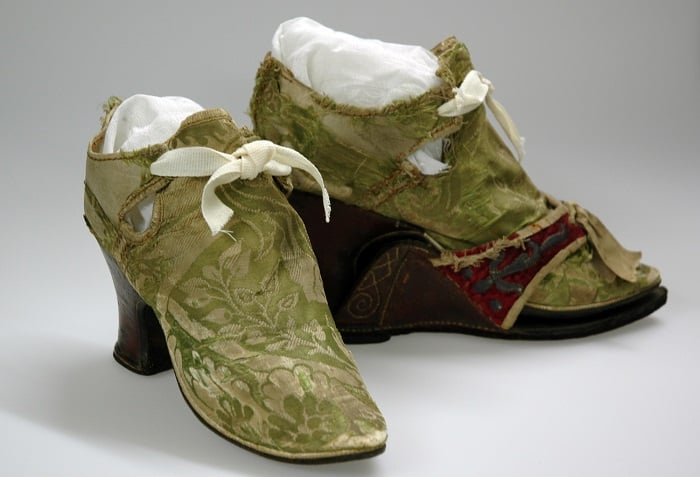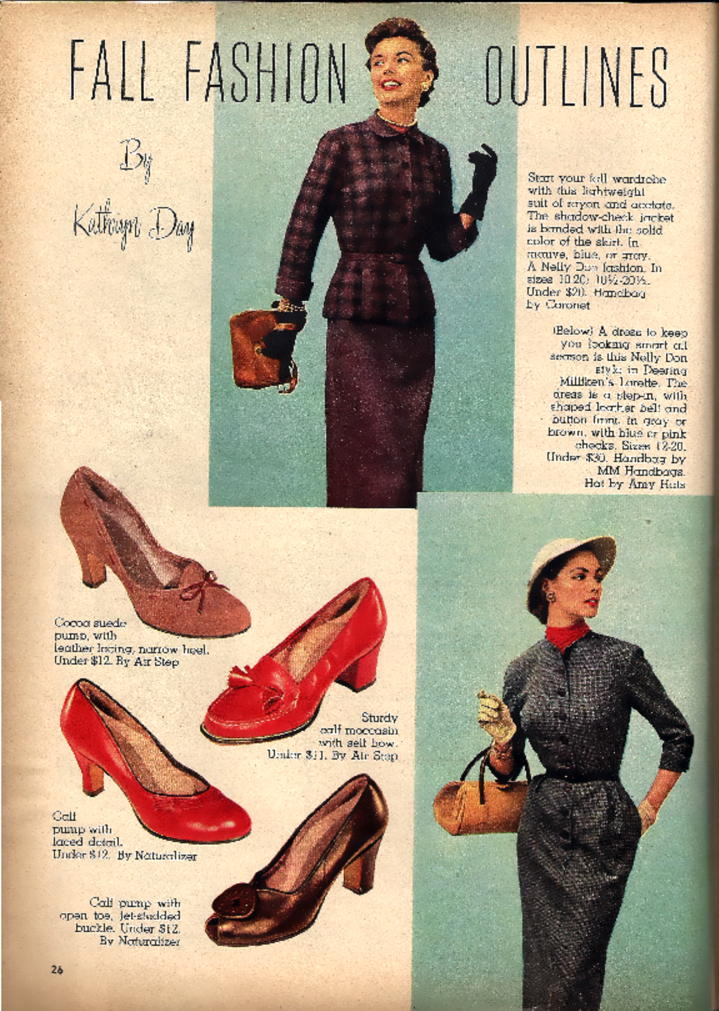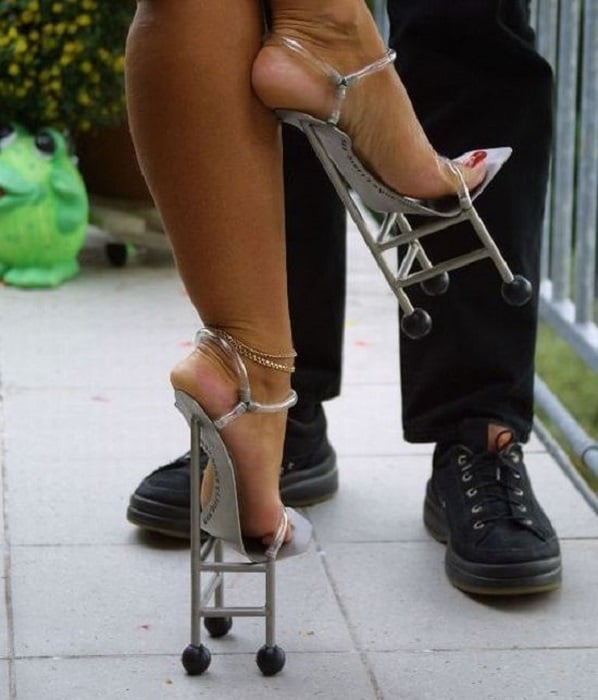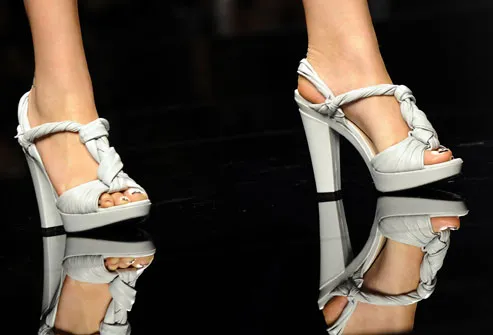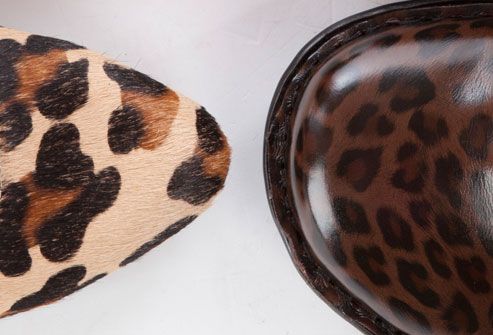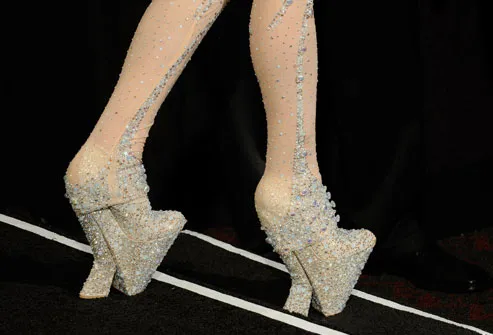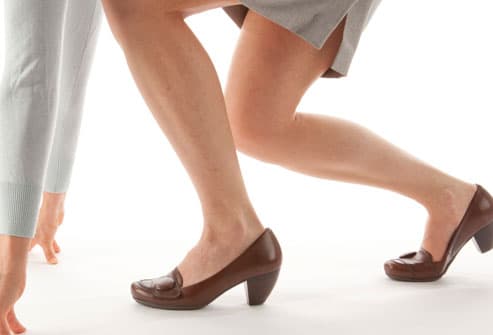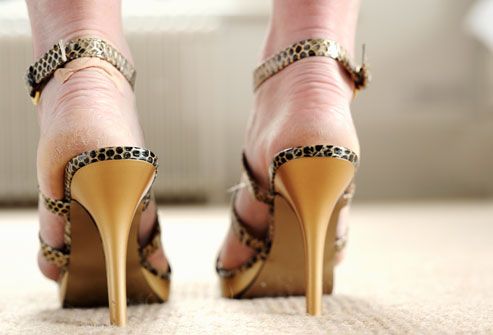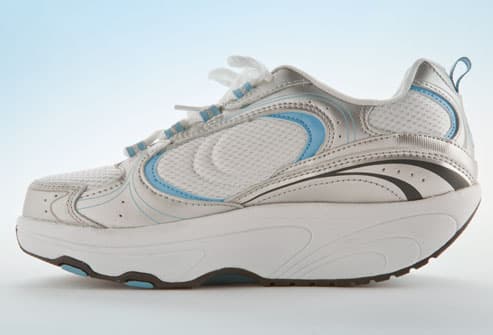The Heel vs The Flat – What do you think???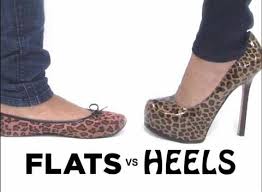
Throughout fashion history, it has always been the norm that women should have various looks for the different venues in their life. Although the outfit and jewelry make up the better part of the ensemble, the shoes are always the last piece to the puzzle.
Here is a brief history that I found on the shoe.
See Ref 1 below:
The History of the Shoe:
It’s hard to imagine a time before the invention of shoes. Yet what started as a practical venture has grown into a varied, booming industry just as concerned with art as it is with functionality. Though all shoes share basic characteristics, their coloring, materials, and designs have transformed drastically over thousands of years in the fascinating history of footwear.
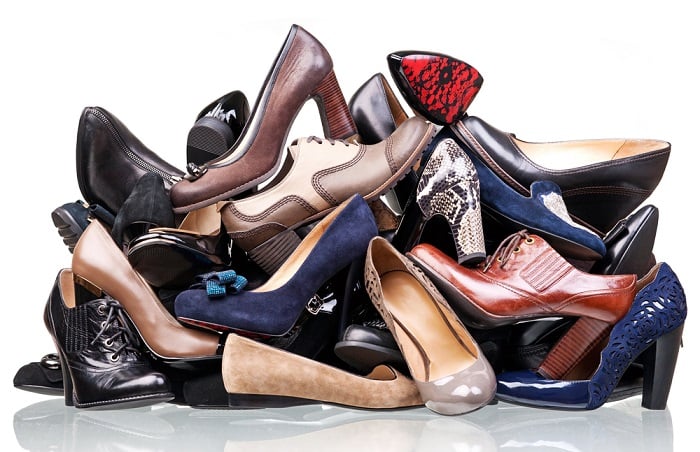 History of footwear Pile Of Shoes
History of footwear Pile Of Shoes
Source: US Storage Research
From archeological and paleoarcheological evidence, experts hypothesize that shoes were invented around in the Middle Paleolithic period approximately 40,000 years ago. However, it wasn’t until the Upper Paleolithic period that footwear was consistently worn by populations. The earliest shoe prototypes were soft, made from wraparound leather, and resembled either sandals or moccasins.
Fascinating History Of Footwear
Jump ahead a few thousand years to the beginning of modern footwear. In Europe’s early Baroque period, women’s and men’s shoes were very similar, though fashions and materials differed among social classes. For common folk, heavy black leather heels were the norm, and for aristocrats, the same shape was crafted out of wood.
In the 18th century, fabric shoes like the silk pair below were very much a la mode.
Source: Two Nerdy History Girls
In the early 1800’s, women’s and men’s shoes finally began to differ from one another in style, color, heel, and toe shape. Cloth-topped shoes made an appearance during this era, and boots grew exceedingly popular. After much fluctuation, the standard for a man’s heel finally settled at 1 inch.
Up until 1850, shoes were made straight, meaning that there was no differentiation from left and right shoes. As the twentieth century approached, shoemakers improved comfort by making foot-specific shoes.
In the 20th century, the face of footwear changed drastically from decade to decade. This was due in part to a variety of technological advances that made the shoemaking process simpler.
During the Great Depression, black and brown shoes dominated the American market. Shortly after, Oxfords became a popular male choice and cork-soled, platform shoes grew popular among women.
Though men’s shoe styles remained relatively unchanged following World War II, women’s shoes made another dramatic alteration in their appearance. Women’s shoes were now arched, sophisticated and made to highlight the foot. Delicate heels grew narrower as the decade progressed.
Source: Edelweiss Patterns
As the female presence in the workplace grew in the last few decades of the 20th century, so too did their heels. In the early seventies, platform shoes and wedges were popular among women, though they became less-so in the eighties and nineties. Men’s shoe trends, however, were markedly static, as oxfords and loafers remained the dominant style. In 1986, Doc Martens, once heralded as an anti-fashion statement, were considered socially acceptable.
These days, there are shoes for every occasion, mood, and preference. There has also been a movement away from styles that focus primarily on comfort and function, as many designers are shifting interest from a matter of practicality to that of aesthetics. Celebrities like Lady Gaga have introduced the world to footwear that’s more art and armadillo than it is clothing. If footwear trends continue in this fashion, we can expect the shoes of the future to be even more out-of-this-world.
So I ask you, if this is fashion etiquette, why has the status quo changed? Why are some in the fashion world reverting back to wearing flats instead of the heel? Is there a medical aspect to this argument?
I started looking to see what I could find and discover what opinions where out there on this subject. Believe me when I tell you there are quite a few because as the saying goes – “opinions – everybody has one”. Trying to find the most credible ones is the task.
In my quest for an answer, I found this study.
See Ref 2 below:
Heels or Flats? Your Health May Depend On It
Tags: flatgate, high heels, feet, foot pain, Cannes Film Festival, diabetes
 You might have heard about the recent “flatgate” controversy, in which women not wearing high heels reportedly were barred from the red carpet at the Cannes Film Festival premiere of the new Cate Blanchett film, Carol.
You might have heard about the recent “flatgate” controversy, in which women not wearing high heels reportedly were barred from the red carpet at the Cannes Film Festival premiere of the new Cate Blanchett film, Carol.
Discussion raged in the press and on social media with everyone from actress Emily Blunt to the American Podiatric Medical Association weighing in. The festival director later apologized, but it made me wonder whether high heels might actually pose a public health risk.
The answer is maybe.
Anyone with chronic foot trouble will tell you that feet are one of the most underappreciated yet important keys to overall health. Each human foot contains 26 bones, 33 joints, 107 ligaments, 19 muscles and associated tendons – all taking tremendous pounding over the years. About 75 percent of Americans will experience foot problems in their lifetime, making it more difficult to get around and to exercise.
A recent survey by the American Podiatric Medical Association found that high heels are the shoes most often to blame for foot pain, with 71 percent of wearers reporting discomfort. According to the American Osteopathic Association up to a third of women suffer lasting damage due to habitual heel wearing.
Perhaps not surprisingly, a study in the Journal of Applied Physiology found that high heels can permanently change the way you walk and increase risk for strain injuries. Standing in heels affects your entire posture. Putting more weight on your toes tilts your body forward and forces you to lean backwards and arch your back to maintain balance. This puts strain on your knees, hips and lower back, which can damage nerves. Chronic heel use can also result in ingrown toenails, bunions and irreversible tendon damage.
Fortunately, there are things you can do to minimize the health risks of chronic high-heel use:
- Choose shorter heels or flats more often. If you wear heels, pick ones that are less than two inches tall with a wide heel base for stability;
- Use insoles to reduce impact on your joints;
- Make sure your shoes are the right size so your foot doesn’t slide forward and put even more pressure on your toes;
- Pick a shoe with cushioning in the front and a wide enough toe box to let your toes wiggle;
- Don’t wear heels on days when your schedule includes lots of walking or standing;
- Alternate your shoes. Avoid wearing high heels all day by wearing flats during commute times; and
- Stretch your calf muscles and feet every day.
 Don’t let yourself get sidelined from physical activity because of preventable foot problems. For example, a bunion surgery can take as much as six months of recovery time. The National Foot Health Assessment survey showed that the percentage of adults participating in physical activity is cut almost in half among those who rate their foot health as fair or poor.
Don’t let yourself get sidelined from physical activity because of preventable foot problems. For example, a bunion surgery can take as much as six months of recovery time. The National Foot Health Assessment survey showed that the percentage of adults participating in physical activity is cut almost in half among those who rate their foot health as fair or poor.
If you have diabetes, your feet are at even greater risk for health problems, and choosing shoes carefully can be even more critical. In fact, every 20 seconds, someone loses a limb to diabetes, and many of these amputations could have been prevented with proper foot care. Take three minutes to conduct a home foot exam developed by doctors at UA College of Medicine – Tucson. It could save a limb – or even a life.
Now this all sounds a bit daunting. i really love my heels. I wear them all the time. I am only 5 ft 5 in and my husband is 6 ft 6 in. I love to be his shoulder prop when he needs one, but I refuse to let him use my head because I am too short for him to reach my shoulders!!!! So, I need all the height that I can get. Also, I am very comfortable in my heels which average in heel height between 2.5 to 4 inches. i have over 300 pairs of shoes and 90% of them are my heels. So based on the above information, am I supposed to give up wearing my heels?! I think not!!!
The heel, I feel, helps give the wearer an air of confidence,style and beauty – who would not look confident in a pair of 4 inch heels? They also give the allusion of being sexy, alluring and daring. As a woman who is height challenged, I refuse to give this up.
As a result, I went in search of additional information to this controversy and found this on WebMD. There is hope!!!
See Ref 3 below:
Culprit: Ballet Flats
Brenner compares these dainty shoes to walking on cardboard. “There’s no arch support whatsoever,” she tells WebMD. That keeps the feet from functioning optimally and can lead to knee, hip, and back problems. Poor arch support is also associated with a painful foot condition called plantar fasciitis.
Solution: Orthotic Inserts
If you love the look of ballet flats, over-the-counter inserts (shown here) may help prevent mild foot pain. Heel pads can provide extra cushioning for achy heels. And custom orthotics can ease a whole range of foot pains and problems. Podiatrists prescribe these inserts to provide arch support and reduce pressure on sensitive areas. Prescription orthotics can be pricey, but are sometimes covered by insurance.
And:
Ref 1: http://allthatsinteresting.com/fascinating-history-footwear
Ref 2: http://uahs.arizona.edu/blog/2015-05-29/heels-or-flats-your-health-may-depend-it
Ref 3: https://www.webmd.com/pain-management/ss/slideshow-worst-shoes-for-your-feet

